Since 2001, in Swaziland, teenage girls have had to wear large
woollen tassels as a sign of their chastity. Now news comes that
Swaziland's King Mswati III has ended a five-year sex ban he
imposed on the kingdom's teenage girls a year early and there
is to be a ceremony where all tassels are burned. The sex ban was
allegedly imposed to fight the spread of HIV/Aids.
The king fined himself a cow for breaking the ban by marrying again
– he married a 17-year-old girl as his ninth wife just two months
after imposing the sex-ban in September 2001, sparking
unprecedented protests by Swazi women outside the royal palace.
Swaziland has one of the world's highest HIV infection rates,
at about 40% of the population. Meanwhile, the health ministry has
released new figures which show that 29% of Swazis aged 15-19 are
HIV positive and for pregnant women, the figures were 42%.
British airline bmi plans to launch daily services to Mumbai. Bmi,
which hopes to compete with larger rivals British Airways and
Richard Branson's Virgin Atlantic, starts the four-times-a-week
service from London to Mumbai this Saturday.
Kenya Airways will start direct flights to Istanbul in June 2005,
hoping to serve an increasing number of African traders visiting
Turkey. The twice weekly flights to Istanbul will make Kenya
Airways the only airline from sub-Saharan Africa to fly to Turkey,
the airline said.
Mexico's government is privatising top carriers Mexicana and
Aeromexico, and has recently handed out concessions to low-cost
airlines. A Mexican billionaire called Carlos Slim and broadcaster
Televisa are joining forces in a new low-cost airline to be called
Vuela. Vuela already has a concession to operate and expects to
begin flights in the first half of next year from the international
airport in Toluca, west of Mexico City. Earlier in July 2005,
Brazilian airline Gol said it planned to launch a low-cost carrier
in Mexico. Another new airline, ABC Aerolineas, also plans to begin
service in the low-cost market, which has quickly grown in the
United States and Europe with mixed results.
Yes, it is possible to tour one of the most famous television
centres in the world. The tour lasts up to 2 hours. You'll see
into the studios, visit BBC News, play in the interactive studio
and be shown around by well-informed, entertaining guides.
Please note that Television Centre is a working building so no two
tours are ever the same.
Pre-booking is essential. Regular tours Monday to Saturday. They
are open to anyone over 9 years old.
Prices – Adult £8.95 Concession £7.95
Students £6.50
Children (over 9 years) – £6.50
Family ticket (2 adults & 2 children or 1 adult & 3
children) £25.00
Group rates available
Prices valid until 31st March 2006
To book tickets:
Please call: 0870 603 0304
Outside the UK call: +44 28 9053 5904
Textphone for hearing-impaired callers: 0870 903 0304
If you have any special interests or requirements please state them
at the time of booking.
The Inka Porter Project has issued a new set of environmental
guidelines for trekkers on the Inca Trail in Peru and other Andean
hiking circuits. Visit their website at www.peruweb.org/porters for the full
guidelines, which give advice on dealing with rubbish, washing with
biodegradable soap, using refillable water bottles, toilet
etiquette while trekking, and how best to respect flora and fauna.
Reunion Kingston London Sunday 11th Sept 2005 for any member of
Globetrotters who travelled overland to India or on the rail tours
organised by Butterfields. Please e-mail butterfieldashley@yahoo.co.uk
In a speech accusing the South African government of failing to
make crime a priority issue, a South African politician claims that
the murder rate in South Africa is roughly the same as the death
rate from terror attacks on civilians in Iraq. “The murder
rate in South Africa, at about 43 murders per 100 000 people, is
roughly the same as the death rate from terror attacks on civilians
in Iraq” were the figures quoted. “So, despite the
government's claims that crime is 'stabilising', South
Africans are still living in what amounts to a state of civil war
between criminals and law-abiding residents.
According to the South African Law Commission, only 6% of violent
crimes reported to police result in a conviction, and 75% do not
even make it to court. South Africa's overcrowded prisons were
described as “universities of crime”. and said they are
not rehabilitating criminals. An alarming recent trend is the rise
in crime involving youths. “Forty-four percent of the children
under 14 who were taken to Durban mortuaries in 2004 had been shot
dead, for example.” Young people are also, increasingly, the
perpetrators of crime. “The number of children convicted of
violent crime jumped by 5% from 2003 to 2004, according to the
National Institution for Crime Prevention and the Reintegration of
Offenders.
Spotted by Webmaster Paul, here's a satellite photo from Google
of the
Lake District.
French President Jacques Chirac has again urged world leaders to
impose a levy on airline tickets to finance extra aid for Africa.
If accepted, the tax would be imposed on tickets of planes leaving
from airports in participating countries.
Chirac, who told the World Economic Forum in January that a tax of
USD$1 per airline ticket could raise USD$10 billion a year to fund
campaigns against diseases in Africa, pressed his case in a letter
he wrote to more than 140 world leaders.
“I offer you to associate yourselves with the establishment of
an international solidarity contribution on plane tickets, aimed,
particularly, at financing the fight against AIDS, tuberculosis and
malaria”.
The Group of Eight industrialized nations have decided to consider
imposing a levy on airline tickets to finance extra aid for Africa,
a proposal which has run into opposition in Europe and the United
States.
Chirac's idea has received support from Germany, but even
though talks so far have centered on a voluntary tax, some other
European governments, including tourist destinations Greece and
Italy, have given the idea an icy reception.
Every September the annual Open House
London event takes place and this year the dates are 17th &
18th September 2005. Over 600 buildings are opening their doors to
everyone and turning the capital into a living architectural
exhibition. And it's absolutely free!
Two former America West pilots have been convicted of operating a
packed passenger plane while drunk and sent to prison on Thursday
by a Florida judge, who called their crime “outrageous and
horrendous.”
Judge David Young sentenced Thomas Cloyd, 47, to five years behind
bars — the maximum term — and Christopher Hughes, 44, to 2-1/2
years in prison for trying to fly from Miami Airport on July 1,
2002, after a night of beer drinking.
The pilots' Airbus A319 aircraft was being towed to the runway
for takeoff to Phoenix with 124 passengers and three flight
attendants aboard when it was ordered back to the terminal. A
security screener had reported that the pilots smelled of alcohol.
They had spent the evening before playing pool and drinking at a
Miami area bar. They left the bar around 5 a.m. after running up a
tab for 14 jumbo glasses of beer — the equivalent of nearly 22
pints (10.5 litres) — and showed up late for the 10:30 a.m.
flight. FAA rules bar pilots from consuming alcohol for eight hours
before a flight.
Unusually high concentrations of jellyfish have appeared along
Spain's Mediterranean coast this summer. The Red Cross said its
lifeguards had treated almost 11,000 people for stings on beaches
so far this season in the north eastern region of Catalonia alone,
twice the number from the same period last year, when the jellyfish
count had already begun to rise. Factors like drought, heat and
over fishing contribute to a rising jellyfish count, according to
the international environmental group Oceana.
France: water-rationing is in place across more than half of
France, with the west particularly affected by drought. A plague of
locusts in the south of France, around Aveyron, has been put down
to the continuing dry, hot weather.
Spain: is suffering its worst drought since records began in
1947, with the east particularly badly hit. Temperatures have risen
to 40C (104F) in parts of Andalusia, in the south. Water is also
being rationed across half the country, including in major tourist
centres.
Portugal: Portugal faces its worst dry spell since the
1940s. Some 97% of the country is suffering a severe or extreme
drought, ministers say. Shortages are particularly acute in the
Algarve region, where the population more than doubles during the
peak tourist season.
Italy: the temperature has topped 35C (95F) in cities
including Milan, Florence and Turin. Several people have died in
northern Italy as a result of the intense heat.
According to the Nepal Tourism Bureau, in the first four months of
this year, covering the peak spring tourist season, Nepal logged
roughly 72,000 tourists, a reduction of 34 percent from the same
period last year. The Tourism Board has also tried to lure back
trekkers, slashing fees by half – to about $5,000 for a team of
seven – for some prime peaks, including Kanchenjunga, which at
8,600 meters, or 28,200 feet, is the world's third-highest
mountain. Government tourism officials have said that Nepal, after
King Gyanendra's emergency proclamation, is safer than ever
before.
The Maoist insurgents, who have been fighting the government since
1996, officially welcome foreign tourists. Well, they would – a
significant part of their income is derived from charges or tolls
extracted from individual tourists, lodges and other
tourism-related industries.
Many foreigners have stayed away from Nepal. Peace Corps activities
were suspended in September because the U.S. government lists the
Maoist rebel group as a terrorist organization so American citizens
are forbidden to contribute funds, goods or services to or for the
benefit of the Maoists, according to the State Department.
Huge parts of the countryside are effectively no man's land,
where the rebels or government troops may be found. On the
Annapurna trail, there are plenty of rebels who try to collect
their taxes from tourists and it is considered dangerous to refuse
the demands of the guerrillas. The Mount Everest trail from Lukla
onward remains untouched by fighting, according to trekking groups
that organize tours to Everest.
Sometimes a tourist hotel is bombed, but it is said that this some
of these attacks are staged because the hotel owner's payments
to the guerrillas have been regarded as unsatisfactory. The latest
incident came on May 20, when a hotel in Pokhara, in the foothills
of the Himalayas and a stop on the Annapurna trail, was attacked
with a homemade bomb, injuring two waiters.
Educational travel conference at York St John College in York, UK
on Saturday 15th October 2005 from 9.30 am to 5.00 pm. Tickets cost
£15 (£10 for students) including lunch and refreshments.
A practical day of advice and guidance to help prepare and support
young travellers on their gap year travels.
Young travellers, educators and parents are
encouraged to attend this one day Educational Travel Conference
& Exhibition which will provide information & options on
how to get the maximum out of travel experiences whilst keeping
safe.
Full programme of experts including former BBC war correspondent
and independent MP, Martin Bell and Deidre Bounds, founder of
Leeds-based i-to-i the UK's largest company specialising in
volunteer travel.
For further information, see:
www.carolinesrainbowfoundation.org
When the first modern humans evolved in Africa, they lived mainly
on meat hunted from animals. Scientists had always thought the
exodus from Africa around 70,000 years ago took place along a
northern route into Europe and Asia. Now, according to a new
genetic study, it seems that early modern humans followed the
beach, possibly lured by a seafood diet. The study believes that
humans quickly reached Australia but took much longer to settle in
Europe. Dr Martin Richards of the University of Leeds, who took
part in the study, says the first humans may have moved south in
search of better fishing grounds when stocks in the Red Sea
dwindled due to climate change. The new research suggests they
moved along the coasts of the Arabian peninsula into India,
Indonesia and Australia about 65,000 years ago. An offshoot later
led to the settlement of the Middle East and Asia about 30 to
40,000 years ago.
Need to convert currency?
Take a look at The
Globetrotters Currency Converter – get the exchange rates for
164 currencies The
Globetrotters Currency Cheat Sheet – create and print a
currency converter table for your next trip.
Potential good news for those wishing to travel to Spain. According
to newspaper ABC, Spain's flag-carrier Iberia will launch a
low-cost airline at the beginning of next year. The new airline may
be called “Mediterranea” and will have its hub in the
Mediterranean city of Barcelona, the paper said. An Iberia
spokeswoman said it was still considering the option of a no-frills
sibling, but nothing had been decided yet. “We still don't
know whether we're going to do it or not,” the spokeswoman
said. “It's something that will be covered in the
strategic plan we'll unveil in September.”

 We are sorry
to say that Mac is not very well, but he is still e-mailing
strong and recently sent the Beetle a collection of travel
reminiscences about China.
We are sorry
to say that Mac is not very well, but he is still e-mailing
strong and recently sent the Beetle a collection of travel
reminiscences about China.
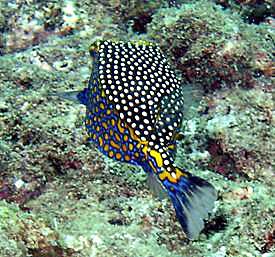 Very good
diving, all drift diving, some strong currents, including down
currents – hhhmm – oh, and dynamite fishing whilst we were in the
water! This was a little scary. The previous day we'd been
out diving around Menjangen Island when we unexpectedly came
across several men diving along side us, breathing in compressed
air from an umbilical cord leading from a boat on the surface.
They had a couple of weights wrapped around their waist but no
other safety equipment, like a gauge to tell them how deep they
were or how long they'd been in the water.
Very good
diving, all drift diving, some strong currents, including down
currents – hhhmm – oh, and dynamite fishing whilst we were in the
water! This was a little scary. The previous day we'd been
out diving around Menjangen Island when we unexpectedly came
across several men diving along side us, breathing in compressed
air from an umbilical cord leading from a boat on the surface.
They had a couple of weights wrapped around their waist but no
other safety equipment, like a gauge to tell them how deep they
were or how long they'd been in the water.
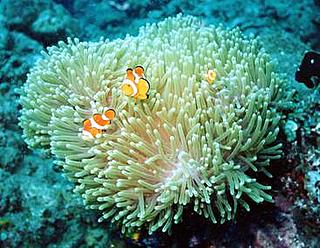 This was not
quite in the protected WWF marine reserve where I mostly dived,
but they most definitely should not have been doing this. They
were no more pleased to see us than me and the dive instructor I
was with, were to see them. They knew they were 'in the
wrong' and it was a very awkward situation under water, a
little aggressive and certainly very threatening. When we got
back to our dive boat, and were returning to our hotel, the
Japanese instructor (a tiny little thing, with the strength of
Goliath) said in Indonesian (which I picked up a fair bit of!) to
the guys on the pirate boat that she was going to call the
police. They were not impressed.
This was not
quite in the protected WWF marine reserve where I mostly dived,
but they most definitely should not have been doing this. They
were no more pleased to see us than me and the dive instructor I
was with, were to see them. They knew they were 'in the
wrong' and it was a very awkward situation under water, a
little aggressive and certainly very threatening. When we got
back to our dive boat, and were returning to our hotel, the
Japanese instructor (a tiny little thing, with the strength of
Goliath) said in Indonesian (which I picked up a fair bit of!) to
the guys on the pirate boat that she was going to call the
police. They were not impressed.
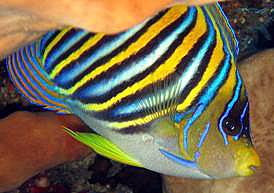 The next day
we dived in a different part of the same marine sanctuary, when
we heard this massive boom. There is only one sound, that, even
under water sounds like that – explosives. I was rather scared,
to put it mildly! Someone close by was dynamite fishing. It was
not a good feeling, and I thought that maybe, just maybe, my time
was up, and this is how it was all going to end – making enemies
with Indonesians stealing tropical fish who dynamited us out of
the water for revenge. But, as you can see, they did not dynamite
us, but there were four explosions on that dive and they were
further away than I first thought, but it was still very scary,
the whole water and landscape seems to vibrate and shake, almost
as if it was crying.
The next day
we dived in a different part of the same marine sanctuary, when
we heard this massive boom. There is only one sound, that, even
under water sounds like that – explosives. I was rather scared,
to put it mildly! Someone close by was dynamite fishing. It was
not a good feeling, and I thought that maybe, just maybe, my time
was up, and this is how it was all going to end – making enemies
with Indonesians stealing tropical fish who dynamited us out of
the water for revenge. But, as you can see, they did not dynamite
us, but there were four explosions on that dive and they were
further away than I first thought, but it was still very scary,
the whole water and landscape seems to vibrate and shake, almost
as if it was crying.

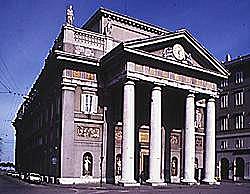
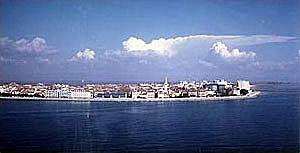 Grado can be reached by the no 21
bus from Trieste. There is also a boat service during the Summer.
Grado can be reached by the no 21
bus from Trieste. There is also a boat service during the Summer.
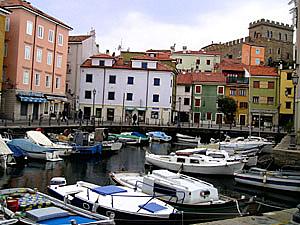 The Slovenian border is just a few
kilometres from Trieste. The Lipica Stud and
Riding School is under a half hour drive from Trieste. It was
originally founded in 1580 by Archduke Charles for breeding royal
horses for the Austrian court. Now you can tour the stud farm (6
Euros) or have a riding lesson, starting at 16 euros.
The Slovenian border is just a few
kilometres from Trieste. The Lipica Stud and
Riding School is under a half hour drive from Trieste. It was
originally founded in 1580 by Archduke Charles for breeding royal
horses for the Austrian court. Now you can tour the stud farm (6
Euros) or have a riding lesson, starting at 16 euros.
 Trip duration: 19 days
Trip duration: 19 days
 Eventually, 3 hours after arriving,
I got to board a ferry. Naturally I was pulled aside and
loaded last, squeezed on between a rental car and the now raised
loading ramp. I didn't share the loaders confidence in
the position of the bike so I decided to stay on the bike for the
incredibly bumpy 20 minutes it took to cross – if I hadn't
the bike would have fallen against the car for sure.
Eventually, 3 hours after arriving,
I got to board a ferry. Naturally I was pulled aside and
loaded last, squeezed on between a rental car and the now raised
loading ramp. I didn't share the loaders confidence in
the position of the bike so I decided to stay on the bike for the
incredibly bumpy 20 minutes it took to cross – if I hadn't
the bike would have fallen against the car for sure.

 before setting up camp (first time
on the trip). The park is stunning and the following day I set
off early to climb the highest peak there (yeah, a bit foolhardy
I know). The trails were easy to follow but the climb was a
tricky one, rising through incredibly dense forest, sat points
resembling something out of Hansel & Gretal, into peat bog
and eventually a tall slope of loose scree.
before setting up camp (first time
on the trip). The park is stunning and the following day I set
off early to climb the highest peak there (yeah, a bit foolhardy
I know). The trails were easy to follow but the climb was a
tricky one, rising through incredibly dense forest, sat points
resembling something out of Hansel & Gretal, into peat bog
and eventually a tall slope of loose scree.